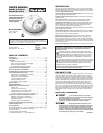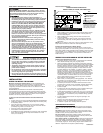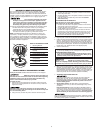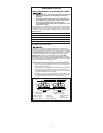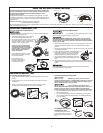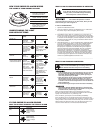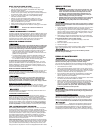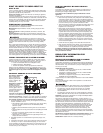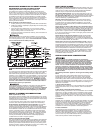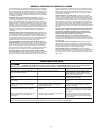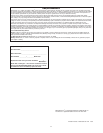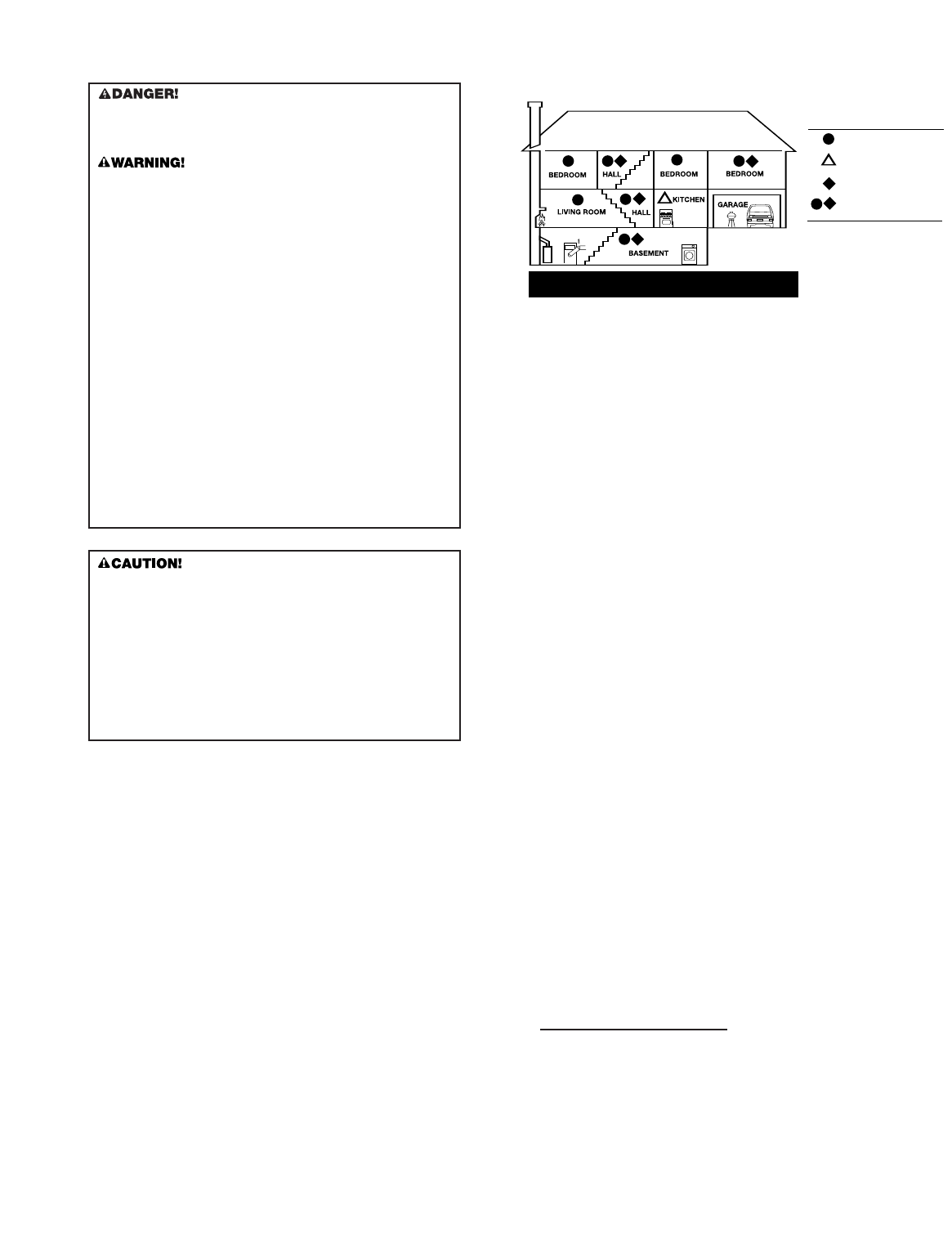
2
INSTALLATION
WHERE TO INSTALL THIS ALARM
Minimum coverage for Smoke Alarms, as recommended by the
National Fire Protection Association (NFPA), is one Smoke Alarm on
every floor, in every sleeping area, and in every bedroom (See
“Regulatory Information For Smoke Alarms” for details on the NFP
A
recommendations).
For CO Alar
ms,
the National Fir
e Pr
otection Association (NFP
A)
recommends that a CO Alarm should be centrally located outside of
each separate sleeping ar
ea in the immediate vicinity of the bedr
ooms.
For added protection, install additional CO Alarms in each separate
bedroom, and on every level of your home.
In general, install combination Smoke and Carbon Monoxide
Alarms:
• On every level of your home, including finished attics and basements.
• Inside every bedroom, especially if people sleep with the door partly
or completely closed.
•
In the hall near every sleeping area. If your home has multiple
sleeping areas, install a unit in each. If a hall is more than 40 feet
(12 meters) long, install a unit at each end.
•
At the top of first-to-second floor stairs.
•
At the bottom of the basement stairs.
•
For additional coverage, install Alarms in all rooms, halls, and storage
ar
eas, wher
e temperatur
es normally r
emain between 40˚ F and
100˚ F (4˚ C and 38˚ C).
Recommended Placement
• When installing on the wall, the top edge of Smoke Alarms should
be placed between 4 inches (102 mm) and 12 inches (305 mm)
fr
om the wall/ceiling line.
•
When installing on the ceiling, place the alarm as close to the
center as possible.
• In either case, install at least 4 inches (102 mm) from where the
wall and ceiling meet. See “A
voiding Dead Air Spaces” for more
information.
NOTE: For any location, make sure no door or other obstruction could
keep carbon monoxide or smoke fr
om reaching the Alarm.
Installing Smoke/CO Alar
ms in Mobile Homes
For minimum security install one Smoke/CO Alarm as close to each
sleeping area as possible. For more security, put one unit in each room.
Many older mobile homes (especially those built befor
e 1978) have little
or no insulation. If your mobile home is not well insulated, or if you are
unsure of the amount of insulation, it is important to install units on
inside walls only.
WHERE THIS ALARM SHOULD NOT BE INSTALLED
Do NOT locate this Smoke/CO Alarm:
• In garages, kitchens, furnace rooms, crawl spaces and unfinished
attics. Avoid extremely dusty, dirty or greasy areas.
• Where combustion particles are produced. Combustion particles
form when something burns. Areas to avoid include poorly ventilated
kitchens, garages, and furnace rooms. Keep units at least 20 feet
(6 meters) from the sources of combustion particles (stove, furnace,
water heater, space heater) if possible. In areas where a 20-foot
(6 meter) distance is not possible – in modular, mobile, or smaller
homes, for example – it is recommended the Smoke/CO Alarm be
placed as far from these fuel-burning sources as possible. The
placement recommendations are intended to keep these Alarms at
a reasonable distance from a fuel-burning source, and thus reduce
“unwanted” alarms. Unwanted alarms can occur if a Smoke/CO
Alarm is placed directly next to a fuel-burning source. Ventilate
these areas as much as possible.
• Within 5 feet (1.5 meters) of any cooking appliance. In air streams
near kitchens. Air currents can draw cooking smoke into the smoke
sensor and cause unwanted alarms.
•
In extremely humid areas. This Alarm should be at least 10 feet
(3 meters) from a shower, sauna, humidifier, vaporizer, dishwasher,
laundry r
oom, utility r
oom, or other sour
ce of high humidity.
• In direct sunlight.
• In turbulent air, like near ceiling fans or open windows. Blowing air
may prevent CO or smoke from reaching the sensors.
•
In ar
eas where temperature is colder than 40˚ F (4˚ C) or hotter than
100˚ F (38˚C). These ar
eas include non-air
conditioned crawl spaces,
unfinished attics, uninsulated or poorly insulated ceilings, porches,
and garages.
•
In insect infested ar
eas. Insects can clog the openings to the
sensing chamber.
• Less than 12 inches (305 mm) away from fluorescent lights.
Electrical “noise” can interfer
e with the sensor
.
•
In “dead air” spaces. See “A
voiding Dead Air Spaces”.
AVOIDING DEAD AIR SPACES
“Dead air” spaces may pr
event smoke fr
om reaching the Smoke/CO
Alarm. To avoid dead air spaces, follow installation recommendations
below
.
On ceilings, install Smoke/CO Alarms as close to the center of the
ceiling as possible. If this is not possible, install the Smoke/CO Alarm
at least 4 inches (102 mm) from the wall or corner.
For wall mounting (if allowed by building codes), the top edge of
Smoke/CO Alarms should be placed between 4 inches (102 mm) and
12 inches (305 mm) from the wall/ceiling line.
On a peaked, gabled, or cathedral ceiling, install the first Smoke/CO
Alarm within 3 feet (0.9 meters) of the peak of the ceiling, measured
horizontally. Additional Smoke/CO Alarms may be required depending
on the length, angle, etc. of the ceiling's slope. Refer to NFPA 72 for
details on requirements for sloped or peaked ceilings.
Continued...
• Connect this unit ONLY to other compatible units. See “How
To Install This Smoke/CO Alarm” for details. Do not connect
it to any other type of alarm or auxiliary device. Connecting
anything else to this unit may damage it or prevent it from
operating properly.
• The battery compartment resists closing unless a battery is
installed. This warns you the unit will not operate under DC
power without a battery.
• Do not stand too close to the unit when the alarm is sounding.
It is loud to wake you in an emergency. Exposure to the horn
at close range may harm your hearing.
• Do not paint over the unit. Paint may clog the openings to the
sensing chambers and prevent the unit from operating properly.
ELECTRICAL SHOCK HAZARD. T
urn off the power to the area
where the Smoke/CO Alarm is installed before removing it from
the mounting bracket. Failur
e to turn off the power first may
r
esult in serious electrical shock, injury or death.
•
This unit will not alert hearing impaired residents. It is
r
ecommended that you install special units which use devices
like flashing strobe lights to alert hearing impaired residents.
• Installation of this unit must conform to the electrical codes
in your area; Articles 210, 760 of NFPA 70 (NEC), NFPA 72,
NFP
A 101; ICC; SBC (SBCCI); UBC (ICBO); NBC (BOCA);
OTFDC (CABO), and any other local or building codes that
may apply. Wiring and installation must be performed by a
licensed electrician. Failur
e to follow these guidelines may
r
esult in injury or property damage.
•
This unit must be powered by a 24-hour, 120V AC pure sine
wave 60 Hz circuit. Be sure the circuit cannot be turned off
by a switch, dimmer
, or ground fault circuit interrupter.
Failur
e to connect this unit to a 24-hour circuit may prevent it
from providing constant protection.
Unit may be connected to
an ar
c fault circuit interrupter.
•
This Smoke/CO Alarm must have AC or battery power to
operate. If AC power fails and the batter
y is dead or missing,
the alarm cannot operate.
•
Never disconnect the power from an AC powered unit to
stop an unwanted alarm. Doing so will disable the unit and
r
emove your pr
otection. In the case of a true unwanted
alarm, use the Silence Feature (if equipped), open a window
or fan the smoke away from the unit. The alarm will reset
automatically when it r
eturns to normal operation. Never
remove the batteries from a battery operated unit to stop an
unwanted alar
m (caused by cooking smoke, etc.). Instead
open a window or fan the smoke away from the unit. The
alarm will reset automatically.
S
UGGESTED AREAS FOR INSTALLING
S
MOKE ALARMS, CO ALARMS, AND COMBO UNITS
SMOKE ALARM WITH
SILENCE FEATURE
CO ALARMS
BOTH, OR COMBINATION
SMOKE/CO ALARMS
SMOKE ALARMS
K
EY:
Suggested locations are based on
NFPA recommendations (NFPA 72
for Smoke Alarms and NFPA 720 for
Carbon Monoxide Alarms). Always
refer to national and local codes
before beginning any installation.
I
n new construction AC and AC/DC smoke alarms MUST
b
e interconnected to meet NFPA recommendations.
BASIC SAFETY INFORMATION, Continued



